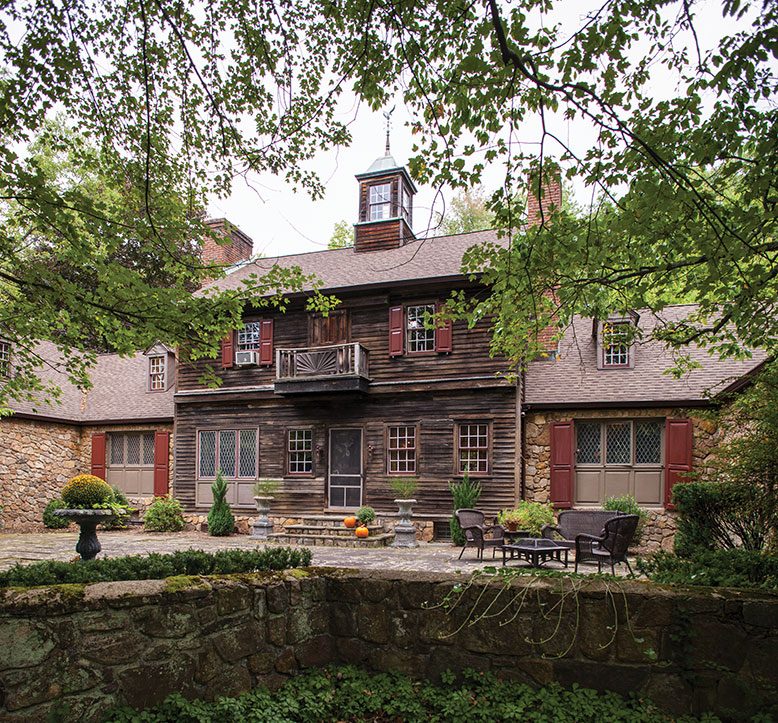
Tom Valenti needed a break from the hustle and bustle of city life. His celebrated restaurant, Ouest, on Manhattan’s Upper West Side, had been going strong for eight years. Seeking a home in the country, he found a jewel on nearly an acre of land in Stanhope, abutting Allamuchy State Park and across the road from historic Waterloo Village.
The History
The magnificent home Valenti stumbled upon is a cobbled-together structure centered around a circa-1840 barn, flanked by two wings added in the late 1950s. The mastermind behind those additions was Percival Leach, an interior designer and antiques collector, known for spearheading the preservation of Waterloo Village, the 19th-century canal town that is now an open-air museum and part of Allamuchy Mountain State Park. Leach and his partner, Lou Gualandi, are widely credited with the restoration of the village in the 1960s; the pair moved the 1840s barn from the village to its current location—adding the two wings. With intense attention to detail, the pair focused on elaborate woodwork, including dentil molding and finely carved doors. All told, they transformed the old barn into a five-bedroom, five-bath, 6,000-square-foot home, then packed it with precious antiques and elaborate window treatments.
Leach had originally purchased the one-acre parcel from financier and philanthropist Finn Caspersen in the late 1950s. Caspersen never built a house on the property, but he still made his mark: He deeded the adjoining land—12,000 acres of it—to the state, essentially creating Allamuchy Mountain State Park. When Valenti bought the house from Leach’s estate in 2009, that was a bonus. “Basically, I have a 12,000-acre backyard,” he says.
The Home
History aside, Valenti quickly set out to make the home his own. The first challenge was furnishing its many rooms. “I had a goodly amount of stuff when I first moved in,” says Valenti, “but I immediately became an antiques- and flea-market hound”—scouring flea markets from Brimfield, Massachusetts, to Adamstown, Pennsylvania.
The process was time consuming. “I shopped,” says Valenti, “and looked for the right piece to suit whatever room I was focused on.”
A longtime collector of art—especially Native American artifacts and American pottery—Valenti scattered his collections around several rooms. He also has a number of significant paintings. “I have a lot of walls to fill,” he jokes. “But I’ve always loved art.”
The barn serves as the home’s main entry, a dark space notable for its gorgeously restored original woodwork. The floor is made of wide planks of pumpkin pine; walls are also pine, assembled with no nails. “The entire space is mitered together,” Valenti says.
Flanking the entry are the wings added in the 1950s. One includes the kitchen and dining room; the other has the den and living room. A long, wide hallway through the old barn connects the spaces. Upstairs, bedrooms are spread out over the three structures, each with a dormer, wooden beams and other architectural details. The home has six working fireplaces, including in the formal dining room, the cozy, wood-paneled den, the guest wing and the expansive living room. Upstairs, there’s a fireplace in the master bedroom and another in Valenti’s home office, a sunny spot where he drafts cookbooks (he has published three) and plans menus and special events.
Ironically, the kitchen is the smallest room in the house; Valenti says he appreciates a compact kitchen. “Everything is within arm’s reach,” he says. “It’s decidedly low-tech.” Appliances are vintage, likely from the 1950s, Valenti thinks. He considered upgrades, but ultimately decided to keep the room as is. “I thought about swapping them out, but I did a little research and discovered there’s a cult for these appliances,” he says. “And I can actually cook on them.” Entertaining at home is a low-key affair, usually a simple dinner and a movie. “I entertain on a small scale here,” he says. “It’s nothing fancy.”
The Chef
When it comes to cooking, Valenti’s Manhattan successes include Gotham Bar & Grill, Allison on Dominick, and his own restaurant, Ouest, a popular neighborhood joint known for braised lamb shank and short ribs. Valenti is widely considered the first to introduce these bargain cuts of meat into fine dining. “I started the lamb-shank thing at Allison on Dominick in the late-80s,” he says. “I started doing beef short ribs a short time later. Both were cheap cuts of meat.”
Critics took note immediately. “This was a time when food was largely driven by California-style cuisine. It was grilled chicken with sun-dried tomatoes over a bed of greens,” he says. Breaking with the times, Valenti started braising meats, a technique he learned from his grandmother as a child growing up in Ithaca, New York. The dining public loved it.
But time and tastes change. Ouest shuttered in 2015. “Making financial sense of a restaurant as a business model is becoming increasingly difficult,” says Valenti. After a short stint at the Strip House in Livingston, he is now looking for a new space on Manhattan’s Upper West Side. “I had a very nice, healthy clientele base there,” he says.
Valenti admits he misses cooking and, luckily for us, has no plans to retire anytime soon.
